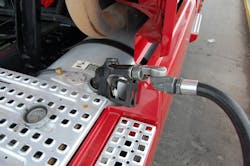Diesel and gasoline prices continued to fall this week across most of the U.S., noted the Energy Information Administration (EIA), while prices for diesel exhaust fluid (DEF) remained relatively stable, according to data tracked by global consulting firm Integer Research.
The national average retail pump price for diesel declined 5/10ths of a penny this week to $3.853 per gallon, which is 5.6 cents per gallon cheaper when compared to the same week in 2013, the agency said.
Only three regions sported prices above the $ per gallon mark: New England, which recorded the largest one-week price drop of 2.5 cents to $4.019 per gallon; California, which reported a 3/10ths of a penny decline to $4.087; and the West Coast, where prices fell 1/10th of a penny to $4.016.
EIA noted, however, that with California removed from the mix the West Coast actually witnessed the only uptick in diesel prices anywhere in the nation – a slim 2/10ths of a penny hike to $3.930 per gallon. The Gulf Coast sported the second largest decline in diesel prices this week of 1.3 cents to $3.759, which is also the cheapest average price for diesel in the U.S.
Where DEF is concerned, Integer reported that national average pump prices remained stable in both the U.S and Canada for July. In the U.S. the average pump price remained unchanged at $2.79 per gallon for the fourth consecutive month, whereas in Canada, the average pump stayed steady at 80 cents per liter (roughly US$3.17 per gallon) after rising one cent per liter in May.
By contrast, the 2.5 gallon jug price for DEF jumped up 8 cents to $5.96 per gallon in the U.S. while declining about 6 cents per liter in Canada – the second consecutive monthly decline in Canadian DEF jug prices, Integer noted.
Gasoline prices also fell this week, with the national average retail pump price dropping 2.4 cents to $3.515 per gallon, which is 11.7 cents lower compared to the same week in 2013, EIA said.
Only in the Midwest did gasoline prices increase: a 7/10ths of a penny hike to $3.416 per gallon. Across the rest of the nation gasoline declined with the biggest drops occurring in New England (a 4.5 cent decline to $3.648 per gallon), the Gulf Coast (a 4.3 cent drop to $3.306, which is also the cheapest price for gasoline in the U.S. this week) and California (a 3.9 cent decrease to $3.574).
On a global basis, a new report from Navigant Research projects that gasoline usage will start to undergo a long-term decline due to a range of what the firm terms “oil consumption reduction policies” in many countries that include subsidizing alternative fuels and alternative fuel vehicles, biofuels mandates, and higher fuel economy requirements for new vehicles begin to gain significant traction.
As a result, Navigant believes that while gasoline consumption for road transportation will continue to rise through 2021, reaching 367.3 billion gallons a year, it will then start falling thereafter – declining to 348.1 billion gallons a year in 2035.
Scott Shepard, a research analyst with Navigant, said that from 2014 to 2035 worldwide gasoline consumption by the road transportation sector should fall 4%.
“The anticipated effects of climate change are driving international cooperation on mitigation efforts, including reducing oil consumption in the transportation sector,” he added. “Markets for both vehicles and fuels have gradually begun to respond to these efforts, and alternative fuels – including electricity, natural gas, and biodiesel - are beginning to have an impact on global oil demand.”
While the market for electric vehicles is growing at a healthy pace, according to Navigant’s research, the biggest driver of this decline in gasoline consumption will likely to come from fuel efficiency improvements to conventional vehicle platforms and the internal combustion engine.
About the Author
Sean Kilcarr
Editor in Chief
Sean Kilcarr is a former longtime FleetOwner senior editor who wrote for the publication from 2000 to 2018. He served as editor-in-chief from 2017 to 2018.
